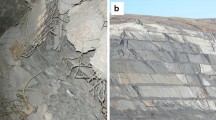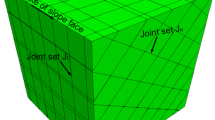Abstract
We present a numerical method for modeling the mechanical effects of nonlinearly-compliant joints in elasto-plastic media. The method uses a series of strain-rate and stress update algorithms to determine joint closure, slip, and solid stress within computational cells containing multiple “embedded” joints. This work facilitates efficient modeling of nonlinear wave propagation in large spatial domains containing a large number of joints that affect bulk mechanical properties. We implement the method within the massively parallel Lagrangian code GEODYN-L and provide verification and examples. We highlight the ability of our algorithms to capture joint interactions and multiple weakness planes within individual computational cells, as well as its computational efficiency. We also discuss the motivation for developing the proposed technique: to simulate large-scale wave propagation during the Source Physics Experiments (SPE), a series of underground explosions conducted at the Nevada National Security Site (NNSS).














Similar content being viewed by others
References
Barton N, Bandis S, Bakhtar K (1985) Strength, deformation and conductivity coupling of rock joints. Int J Rock Mech Mining Sci Geomech Abstr 22:121–140
Cook NGW (1992) Natural joints in rock: mechanical, hydraulic and seismic behaviour and properties under normal stress. Int J Rock Mech Mining Sci Geomech Abstr 29:198–223
Miehe C (1996) Exponential map algorithm for stress updates in anisotropic multiplicative elastoplasticity for single crystals. Int J Numer Methods Eng 39(19):3367–3390
Sahimi M (2011) Flow and transport in porous media and fractured rock: from classical methods to modern approaches. Wiley, New York
Schoenberg M, Sayers CM (1995) Seismic anisotropy of fractured rock. Geophysics 60(1):204–211
Birch F (1960) The velocity of compressional waves in rocks to 10 kilobars: 1. J Geophys Res 65(4):1083–1102
Birch F (1961) The velocity of compressional waves in rocks to 10 kilobars: 2. J Geophys Res 66(7):2199–2224
Bandis SC, Lumsden AC, Barton NR (1983) Fundamentals of rock joint deformation. Int J Rock Mech Mining Sci Geomech Abstr 20:249–268
Pyrak-Nolte LJ, Myer LR, Cook NGW (1990) Transmission of seismic waves across single natural fractures. J Geophys Res Solid Earth 95(B6):8617–8638
Townsend M, Prothro LB, Obi C (2012) Geology of the source physics experiment site, climax stock, Nevada National Security Site. Technical report, Nevada Test Site/National Security Technologies, LLC (United States)
Vorobiev O, Ezzedine S, Antoun T, Glenn L (2015) On the generation of tangential ground motion by underground explosions in jointed rocks. Geophys J Int 200(3):1651–1661
Ghaboussi J, Wilson EL, Isenberg J (1973) Finite element for rock joints and interfaces. J Soil Mech Found Div 99 (Proc Paper 10095)
Desai CS, Zaman MM, Lightner JG, Siriwardane HJ (1984) Thin-layer element for interfaces and joints. Int J Numer Anal Methods Geomech 8(1):19–43
Buczkowski R, Kleiber M (1997) Elasto-plastic interface model for 3d-frictional orthotropic contact problems. Int J Numer Methods Eng 40(4):599–619
Jing L (2003) A review of techniques, advances and outstanding issues in numerical modelling for rock mechanics and rock engineering. Int J Rock Mech Mining Sci 40(3):283–353
Cundall PA (1988) Formulation of a three-dimensional distinct element model—part I. A scheme to detect and represent contacts in a system composed of many polyhedral blocks. Int J Rock Mecha Mining Sci Geomech Abstr 25:107–116
Cundall PA, Hart RD (1992) Numerical modelling of discontinua. Eng Comput 9(2):101–113
Hallquist JO, Goudreau GL, Benson DJ (1985) Sliding interfaces with contact-impact in large-scale Lagrangian computations. Comput Methods Appl Mech Eng 51(1–3):107–137
Dolbow J, Moës N, Belytschko T (2001) An extended finite element method for modeling crack growth with frictional contact. Comput Methods Appl Mech Eng 190(51):6825–6846
Fries T-P, Belytschko T (2010) The extended/generalized finite element method: an overview of the method and its applications. Int J Numer Method Eng 84(3):253–304
Bazant ZP, Oh BH (1985) Microplane model for progressive fracture of concrete and rock. J Eng Mech 111(4):559–582
Kachanov M (1992) Effective elastic properties of cracked solids: critical review of some basic concepts. Appl Mech Rev 45(8):304–335
Vorobiev O (2008) Generic strength model for dry jointed rock masses. Int J Plast 24(12):2221–2247
Wilkins ML (1993) Hemp 3d—a finite difference program for calculating elastic-plastic flow. Technical report, DTIC Document
Vorobiev O (2012) Simple common plane contact algorithm. Int J Numer Method Eng 90(2):243–268
Brown SR, Scholz CH (1986) Closure of rock joints. J Geophys Res Solid Earth 91(B5):4939–4948
Vorobiev O (2010) Discrete and continuum methods for numerical simulations of non-linear wave propagation in discontinuous media. Int J Numer Method Eng 83:482–507
Acknowledgements
The authors would like to thank all members of the Computational Geosciences group at LLNL, particularly T. H. Antoun, E. B. Herbold, and M. B. Rubin, for valuable discussions. The authors wish to express their gratitude to the National Nuclear Security Administration, Defense Nuclear Nonproliferation Research and Development (DNN R&D), and the Source Physics Experiment (SPE) working group, a multi-institutional and interdisciplinary group of scientists and engineers. This work was done by Lawrence Livermore National Laboratory under Contract DE-AC52-07NA27344.
Author information
Authors and Affiliations
Corresponding author
Rights and permissions
About this article
Cite this article
Hurley, R.C., Vorobiev, O.Y. & Ezzedine, S.M. An algorithm for continuum modeling of rocks with multiple embedded nonlinearly-compliant joints. Comput Mech 60, 235–252 (2017). https://doi.org/10.1007/s00466-017-1403-6
Received:
Accepted:
Published:
Issue Date:
DOI: https://doi.org/10.1007/s00466-017-1403-6




